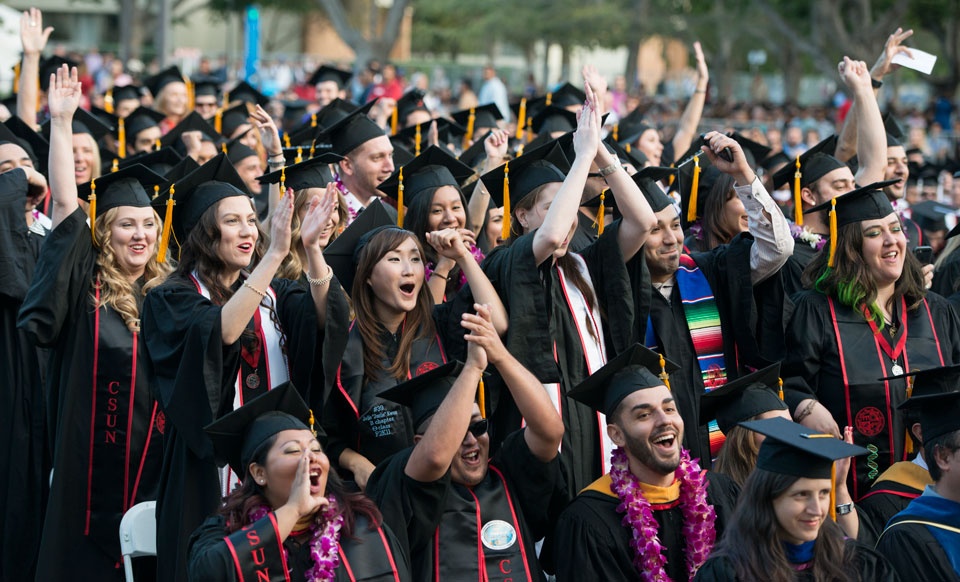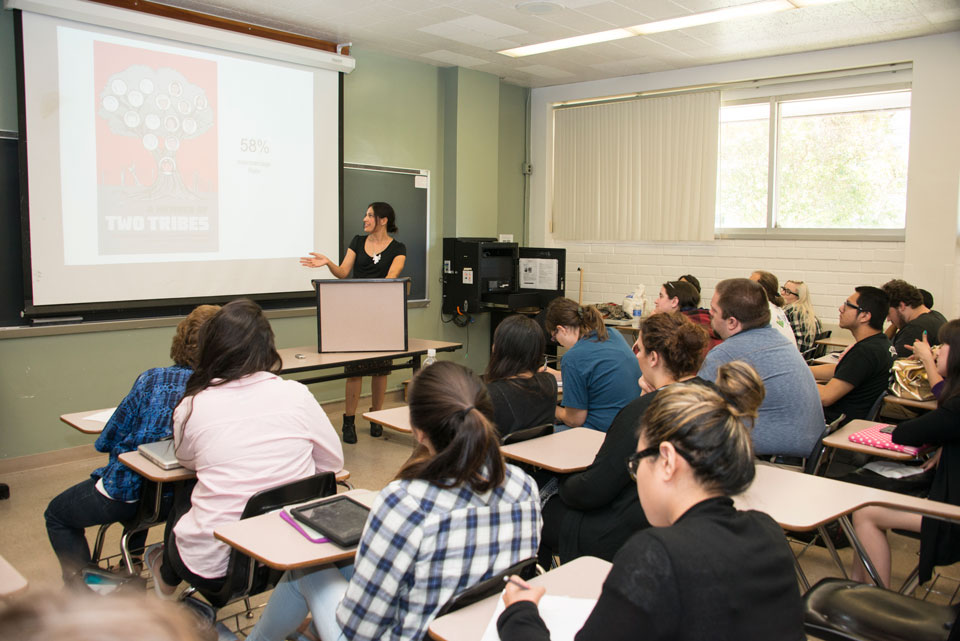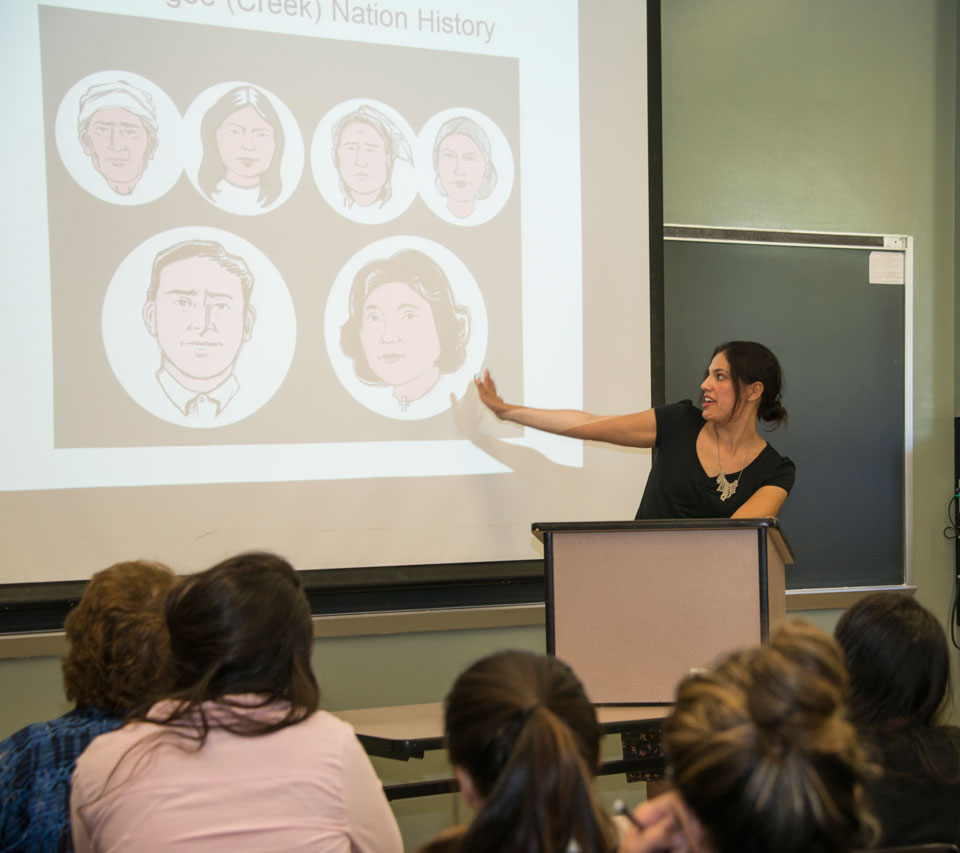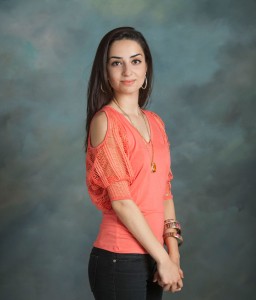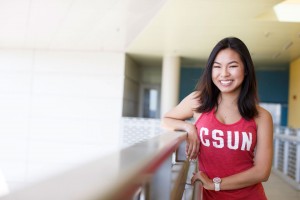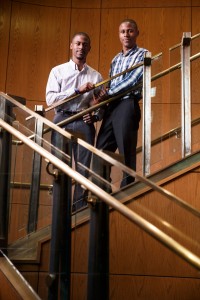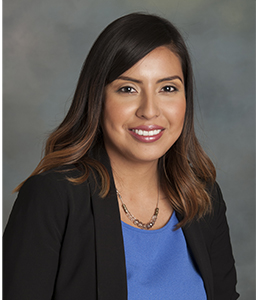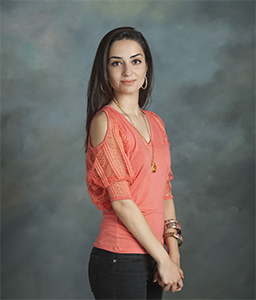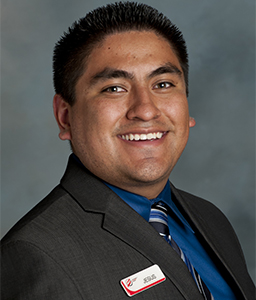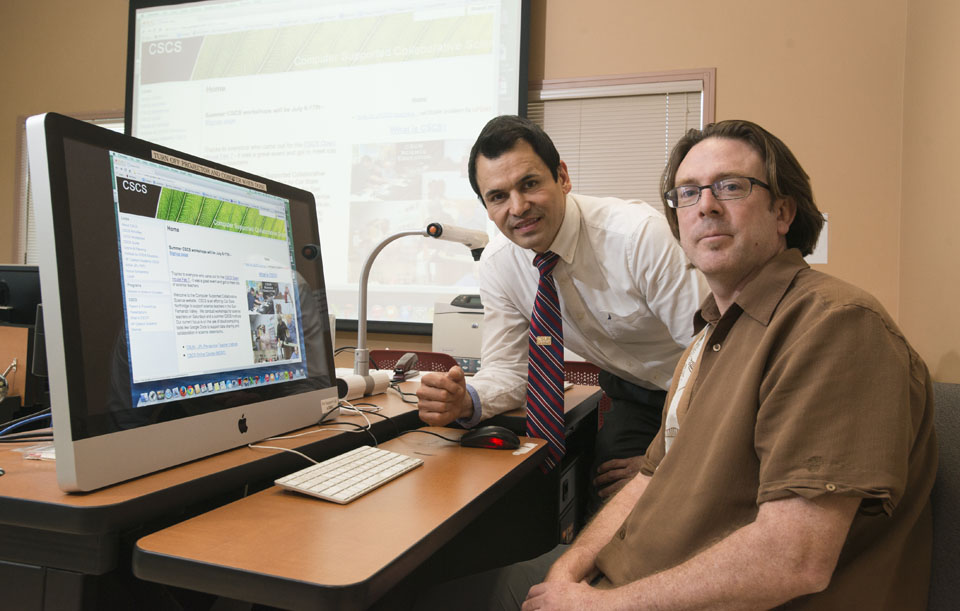![]()
The cheers may be deafening later this week when more than 10,600 students are eligible to take part in California State University, Northridge’s 2015 commencement.
Some of the students are the first in their families to get a college education. Others set out on a path laid out during late-night discussions with their parents or through the determination of loved ones who believed that education would open doors to a world of possibilities.
Below are some of those students’ stories:
![Tania Benjamin]()
Tania Benjamin
Tania Benjamin, B.S. in Cell and Molecular Biology
Tania Benjamin, 21, of Santa Clarita, spent much of her time at CSUN doing research in professor Yann Schrodi’s organometallic and inorganic chemistry lab. She’s been helping him look for ways to prevent the degeneration of olefin metathesis catalysts, molecules that allow for the rearrangement of carbon-carbon double bonds. The research could eventually improve the chemical reactions in drugs developed by the pharmaceutical industry.
“As a freshman, I took Dr. Schrodi’s general chemistry class and learned about his research and how it has applications in the pharmaceutical industry,” she said. “Understanding his research and the impact it could have in that industry made me interested in what he was doing. I asked if I could join his lab, and I’ve been here ever since.”
The work led to a rare research opportunity in 2014. She was one of only 10 students from across the country chosen to intern for the Harvard Catalyst Summer Clinical and Translational Research Program. She worked in the Department of Microbiology and Immunobiology at Harvard Medical School, studying a human enzyme as a potential therapeutic target against cancer.
“It was an amazing experience,” Benjamin said.
Her love of science was sparked by heart-to-heart discussions she had while growing up with her mother, a nurse, and her father, an equipment engineer, both Assyrian immigrants from Iran. They encouraged her to pursue her dreams.
“The talks with my mom really had an impact,” she said. “I spent a lot of nights talking to her about her interactions with her patients. I knew I wanted to go to medical school.”
Despite the demands of her coursework and research in Schrodi’s lab, Benjamin still found time a couple years ago to found Big Buddies, a campus organization that pairs college students as mentors to homeless and disadvantaged youth throughout Los Angeles. The organization currently has partnerships with two shelters and the West Valley Boys and Girls Club. It serves more than 40 young people.
“As a college student, I realized I had various resources that surround me, including other college students,” she said. “I thought, ‘Why not use them to inspire and motivate homeless and disadvantaged youth?’ So, I came up with the idea of Big Buddies.”
Her accomplishments have earned Benjamin distinction as this year’s Wolfson Scholar, the top award for a graduating senior from CSUN. The award is presented each year in memory of CSUN’s first vice president, Leo Wolfson.
Benjamin will take part in CSUN’s commencement ceremony on Monday, May 18, at 6 p.m. She will be heading to medical school at UC San Francisco in the fall. She plans to become an orthopedic surgeon.
![Jacqueline Dinh]()
Jacqueline Dinh
Jacqueline Dinh, B.A. in Communication Disorders
For Jacqueline Dinh, 22, of Northridge, communication is a powerful tool. She tells the story of a five-year-old autistic boy with whom she worked a couple years ago as a speech therapist at the Center for Autism and Related Disorders.
“When he came in, he was not really speaking,” Dinh said. “I was his first therapist. When he left therapy after a year or so, he was telling jokes and singing. His personality emerged with our work. It was rewarding, and I knew this is what I wanted to do for the rest of my life.”
Dinh wasn’t that positive when she first came to CSUN. She just knew she wanted to study something in the sciences. Then she went to a campus employment fair and found a job with the Center for Autism and Related Disorders.
“I loved it, and I knew that I wanted to be speech pathologist,” she said. “CSUN has a great undergraduate program in speech pathology, and the opportunities I have had here to work with patients — while still an undergraduate — have been invaluable. I am so glad I chose this school.”
Dinh said the support she has received at the university inspired her to become a peer mentor within the Department of Communication Disorders and Sciences. It’s a role she plans to continue this fall, when she returns to CSUN to begin her master’s degree in speech pathology.
“The faculty and staff here were so helpful as I was trying to figure out what I wanted to do with my life, and they were there to give me the support and guidance while I was learning about my field,” she said. “I want to be able to do that for my fellow students.”
Dinh, who also earned a minor in religious studies, said she loves learning about different people and different cultures. It’s a tool she believes will be useful in the future.
“I want to work in the public school system when I finish my education,” she said. “I want to eventually work with children with autism and those who use alternative means of communication. I’ve talked to colleagues who work in public schools, and I know how overworked and understaffed they are. I know that by working in the public schools, I can make a difference for children who might not have access to a speech pathologist.
“Communication is so important as a way of expressing ourselves and interacting with others,” she said. “I want to be able to help those who don’t have a voice to find theirs.”
Dinh take part in the commencement ceremony on Saturday, May 16, at 6 p.m.
![Shaniee Parker]()
Shaniee Parker
Shaniee Parker, B.M. in Music Performance (Clarinet) and Music Education
Shaniee Parker fell in love with the oboe as a child when she heard a cousin play the double-reed instrument. When a middle school music teacher let her choose her instrument, she selected … the clarinet.
“It was totally by accident,” she said, laughing. “I couldn’t remember what the instrument was called that my cousin played. I just remembered that it was black and silver. So, when the teacher brought out a clarinet, I said, ‘That’s the one I want.’”
Her cousin told her she got the wrong instrument, and Parker mistakenly assumed she couldn’t switch when she returned to school.
“I’ve been playing the clarinet ever since,” she said, of the single-reed woodwind. “I love the clarinet. It can do so many things. As far as I am concerned, it’s the best instrument there is. It’s got the widest range of any wind instrument and it’s the closest to the human voice.”
Parker, 22, of Chatsworth, was raised by her grandparents, who were determined that she should get as much out of her education as possible. When she got to CSUN, she discovered that the faculty had the same goals. She singled out music professor Julia Heinen in particular.
“She’s so amazing. She plays all over the world and teaches master’s classes everywhere,” Parker said of Heinen. “I’ve learned so much from her — not just how to play the clarinet, but how to carry myself, how to be a woman and not to be intimidated in any aspect of my playing or in pursuing my dreams. I wouldn’t have grown as much as I have without her to inspire me.”
In addition to being a member of the CSUN Wind Ensemble, Colburn Adult Wind Symphony and CSUN Symphony Orchestra, Parker has juggled the course load of two majors — music education and performance with the clarinet, the latter of which requires at least three hours of practice a day — as well as volunteering as a counselor for Camp Ronald McDonald for Good Times, being an active member of the educational foundation LEAP and traveling the state advocating to keep music education in public schools as Miss California Icon.
“Music is the reason I’m where I am today,” Parker said. “Even if you don’t want to become a professional musician, music is so important in helping kids learn about themselves and where they want to go, in addition to giving them an appreciation for the arts. I can’t imagine a world without music. Often, it’s the only way we can communicate across borders or cultures.”
Her love of music inspired Parker to take the next step as a performer. She asked CSUN’s music faculty if they could teach her the art of conducting. She is now assistant conductor of CSUN’s Youth Symphony Orchestra.
“I didn’t know, as a kid, that you could actually buy the CD of the music to movies,” she said. “I would sit there with my tape recorder up to the TV speaker and record it. I’d go back and listen to it, wait for the credits and then wave my hands to conduct it.”
Parker has accepted a graduate fellowship to continue her music performance studies at UCLA this fall. She plans to continue conducting.
Parker will take part in the commencement ceremony at 8 a.m. on Saturday, May 16.
![Demonte “Tray” Thompson, left, and Demontea “Tae” Thompson.]()
Demonte “Tray” Thompson, left, and Demontea “Tae” Thompson.
Demonte “Tray” Thompson, B.S. in Finance, and Demontea “Tae” Thompson, B.S. in Management
“There are a lot of people going nowhere fast,” said Demontea “Tae” Thompson, 22, of Northridge. “If you know your goals and you have the people to lead you in the right direction, that’s more important than getting there on a whim.”
Tae and his twin brother, Demonte “Tray” Thompson, 22, of Chatsworth, said they found that guidance at CSUN.
When the twins were born, their mother was unable to care for them and their father wasn’t around. They and two of their 10 siblings were taken into the foster care system and placed in the charge of their great-uncle, a 69-year-old cement finisher who came to California from Arkansas as a young man with only a quarter in his pocket.
“He was an amazing man,” Tae said. “He laid the foundation for our lives. That is something, to me, that is very poetic. He instilled skills that he knew were going to be life-long and that we would need for whatever we set out to accomplish.”
“At an age when he was supposed to retire and live his life lavishly,” said Tray, picking up where his brother left off, “he took on this new responsibility. Recently, he passed away from cancer at age 89. He made sure we learned everything we needed to navigate this world, and we want to carry on his legacy.”
Tae and Tray said they came to CSUN because of the support system, including mentors, the university offers foster youth through its Educational Opportunity Program.
Tray chose finance as a major because he was inspired by a number of entrepreneurial ventures that he and his brother launched as children growing up in Compton, including a Kool-Aid stand.
“One of the courses I had the most fun in was one of the last I took — portfolio management,” he said. “We had a chance to manage more than $2 million in assets from California State University, Northridge’s University Corporation. I loved every bit of it. With our portfolio return, we managed to beat the total return of the S&P 500.”
Tae admitted he briefly considered studying acting at CSUN.
“Theater has always been a means for expressing myself creatively,” Tae said. “I always thought I wanted to be an actor. As I got into my second year, I thought long and hard and realized I wanted to do something where, in the long run, I can be a factotum — someone able to take on various roles. So, I decided on business management. Since my brother was going into finance, I thought we’d start a company or something.”
A couple of years ago, the pair started a YouTube channel called “Twinspire” to offer encouragement and emotional support to foster youth in the community. They also briefly had a clothing line, with the idea of using the proceeds to support foster and underserved youth. The two were also very active on campus, including with the University Student Union and the Black Male Initiative.
Tae, who wrote a book, “Raised From Scratch,” based on their experiences, and Tray also regularly go out into the community to share their story with underrepresented young people, hoping to inspire them to attend college.
In all that they do, Tray said, they try to focus on the “larger picture.”
“To me, the larger picture wasn’t about starting a company,” he said. “It wasn’t about making money off those different things. It was about how we support those people, young men like ourselves in our community, who are striving for excellence.”
Both men will take part in the commencement ceremony at 8 a.m. on Monday, May 18. Tray finished his studies in December and is now teaching financial literacy in CSUN’s financial aid office. Tae will be entering USC’s Master of Education in Postsecondary Administration and Student Affairs program in the fall.





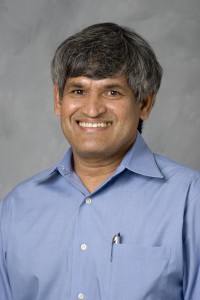







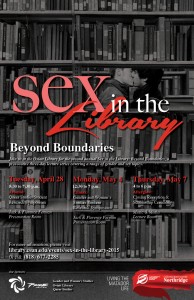 The Oviatt Library at California State University, Northridge will once again partner with CSUN’s gender and women’s studies department, queer studies program, and Pride Center to present their second annual “Sex in the Library” series of lectures and presentations.
The Oviatt Library at California State University, Northridge will once again partner with CSUN’s gender and women’s studies department, queer studies program, and Pride Center to present their second annual “Sex in the Library” series of lectures and presentations.

